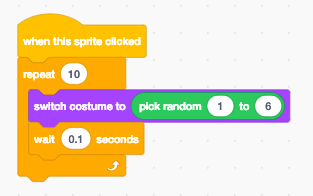![]() I do love using Scratch to enhance teaching other areas of the curriculum. Whilst technically the following resource doesn’t enhance the teaching of probability outcomes, it does enhance the overall experience. I always used to find teaching probability in the initial stages quite boring – I’m sure it’s not a great experience for the children either – “Roll a dice 20 times and record the number of times it hits each side”. Since I started working with Scratch, however, I now ask the children to code their own dice and test how random it is by counting the number of times it lands on each side. I use this as a way into probability. I then ask them to, using the code below, work out how to code other common examples (such as playing cards) that can be randomly selected and record the probability of number / house / colour. The code is very similar, however more costumes need to be created.
I do love using Scratch to enhance teaching other areas of the curriculum. Whilst technically the following resource doesn’t enhance the teaching of probability outcomes, it does enhance the overall experience. I always used to find teaching probability in the initial stages quite boring – I’m sure it’s not a great experience for the children either – “Roll a dice 20 times and record the number of times it hits each side”. Since I started working with Scratch, however, I now ask the children to code their own dice and test how random it is by counting the number of times it lands on each side. I use this as a way into probability. I then ask them to, using the code below, work out how to code other common examples (such as playing cards) that can be randomly selected and record the probability of number / house / colour. The code is very similar, however more costumes need to be created.
I find that this is quite effective as the children have a deeper understanding after it as they have not only seen the result but have also written the instructions for the ‘how’.
I hope that the following code for a random dice game is helpful and that you can see how to use it for teaching probability. I should note, if you extend this to cards instead of dice faces, all costumes (card sides) need to be numbered from 1-52 in order that each can be randomly selected – hopefully it becomes obvious in the PPT. Please feel free to use the below PowerPoint with your learners; I will add the ‘answer’ underneath it on this blog.
Sorry it’s a short post but I am away this weekend.
Have a great week!
Donald
The finished code should look like this:


